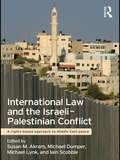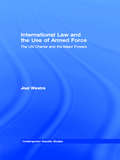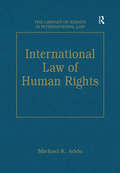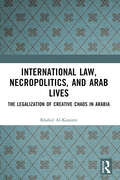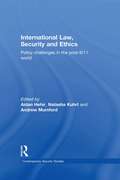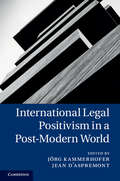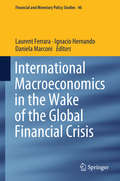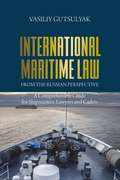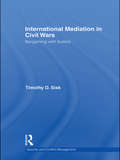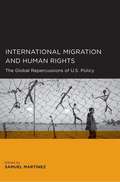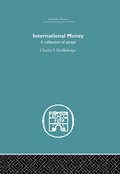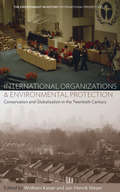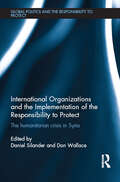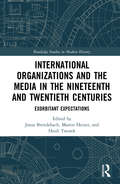- Table View
- List View
International Law and the History of Resource Extraction in Africa: Capital Accumulation and Underdevelopment, 1450-1918 (Routledge Studies in African Development)
by George Forji AminThis book investigates the historical economic and legal regimes that legitimated the resource extraction and exploitation of Africa between the 15th and 19th centuries and led to the continent’s trajectory of underdevelopment in the world system. The book interrogates the economic and legal structures that supported European intervention in Africa. It explores the trade and private property rights which were to shape the economic future of the continent, most notably the trade in human beings as legitimate private property by European powers. The book then looks at the techniques used to submerge African sovereignty under European sovereignty during the scramble for territorial control in the 19th century, concluding with the validation of occupation in international law following the 1884-85 Berlin Conference. The book argues that the doctrines of trade and property rights sanctioned by international law led to a trend of African dispossession that set the continent on a path to underdevelopment, with long-reaching consequences. This book will be of interest to researchers and students across law, history, economics, international relations, and African studies.
International Law and the Israeli-Palestinian Conflict: A Rights-Based Approach to Middle East Peace
by Susan M. AkramThe Israeli-Palestinian conflict has long been intertwined with, and has had a profound influence on, the principles of modern international law. Placing a rights-based approach to the Israeli-Palestinian conflict at the centre of discussions over its peaceful resolution, this book provides detailed consideration of international law and its application to political issues. Through the lens of international law and justice, the book debunks the myth that law is not useful to its resolution, illustrating through both theory and practice how international law points the way to a just and durable solution to the conflict in the Middle East. Contributions from leading scholars in their respective fields give an in-depth analysis of key issues that have been marginalized in most mainstream discussions of the Israeli-Palestinian conflict: Palestinian refugees Jerusalem security legal and political frameworks the future of Palestine. Written in a style highly accessible to the non-specialist, this book is an important addition to the existing literature on the subject. The findings of this book will not only be of interest to students and scholars of Middle Eastern politics, International Law, International Relations and conflict resolution, but will be an invaluable resource for human rights researchers, NGO employees, and embassy personnel, policy staffers and negotiators.
International Law and the Public: How Ordinary People Shape the Global Legal Order
by Geoffrey P. WallaceIn International Law and the Public, Geoffrey P.R. Wallace investigates the public as a crucial, often overlooked, actor in international law. He asks just who is it that counts in the operation of the international legal order. Defying conventional wisdom that sees governments, leaders, generals, lawyers, or elites from the upper echelons of society as the main international legal players, Wallace advances a "popular international law" where ordinary people are considered important legal actors in their own right alongside the usual focus on elites. Far from powerless or unwitting, publics possess both the cognitive and material capacities to understand and contribute to the intricacies of international legal rules. Combining rigorous theorizing with wide-ranging evidence, International Law and the Public is an account of an international legal politics from below, taking seriously the place of ordinary people in international affairs.
International Law and the Relationality of States: A Critique of Theories of Recognition
by Erdem ErtürkThis book critically engages with theories of the recognition of states under international law. Demonstrating that recognition is a constitutive relation that is imperative for the construction of international subjects, the book argues that prevalent theories of recognition fall short of accommodating this imperative. The book traces the source of this shortcoming to Vattel’s notion of absolute sovereignty. A paradox pertains to this notion as absolutely independent states seemingly come into being in a community which sets the law that determines statehood. The book shows how this paradox is reproduced in constitutive theorists’ idea of recognition as a sovereign gesture of consent and declarative theorists’ perception that states can come into being on a singular basis, without any need for interaction. This necessitates a rethinking of the role of recognition in a way that circumvents the problems generated by the notion of absolute independence, whilst accommodating the relational element of coming into being. To achieve this purpose, the book draws upon Hegel’s theory of recognition, supplementing it with Bataille’s and Derrida’s critical readings of Hegel’s thought. In this respect, the book departs from the restrictive economy of recognition that constantly recreates a paradoxical perception of sovereignty, elaborating a more general economy of recognition that accommodates the notion of subjects in flux. This critical engagement with a key notion in international law will appeal to legal and political theorists, as well as scholars and students in international relations.
International Law and the Use of Armed Force: The UN Charter and the Major Powers (Contemporary Security Studies)
by Joel WestraSince the UN Charter came into effect in 1945, there have been numerous incidents in which one or more of the five major powers (at least arguably) violated the Charter's Article 2(4) prohibition of force. Such incidents notwithstanding, this book demonstrates how the Charter restrains the major powers' military actions. As an instrument of international order, the Charter provides a framework of legal rules restricting the use of armed force. Although these rules are subject to auto-interpretation by the major powers (as a consequence of their veto), they create an expectation of compliance that subjects the major powers' military actions to international scrutiny. To reduce the likelihood of resistance from states threatened by such actions, major powers exercise prudential restraint, altering the manner and timing of their military actions in accordance with the legal arguments offered to justify those actions as consistent with the Charter and therefore not threatening to the existing international order. The book evaluates the efficacy of the Charter using large-N methods and five case studies: US intervention in the Caribbean, 1953–61; Anglo- French intervention in Egypt, 1956; Soviet intervention in Hungary, 1956; US–British intervention in Iraq, 1990–98; and US–British intervention in Iraq, 1999–2003. The book's extensive focus on the two Iraq cases provides a basis for timely evaluation of the continuing salience and possible reforms of the UN Charter system. This book will be of much interest to students of security studies, the UN, international law, and international relations.
International Law in East Asia: Issues And Prospects (The\library Of Essays On Law In East Asia Ser.)
by Zou KeyuanAs the worlds political and economic landscape changes in response to the rise of Asian countries such as China, so Asian influences on the global legal order will become more pronounced. Many countries in the region, such as Japan and South Korea, influence the development of international law in various ways, either individually or collectively through multinational organisations such as ASEAN. This collection of published work by leading East Asian scholars covers Asian perspectives concerning various issues in international law, ranging from general perspectives to particular themes such as international economic law, international human rights law, international ocean law, international criminal law, international security law and international dispute settlement. For the first time it provides a comprehensive picture of how and why East Asian countries participate in international law making, as well as comply with international law in their state practices. In so doing, the editors attempt to address the question whether the rising powers in East Asia will change the existing international legal order in future.
International Law of Human Rights: The Compatibility Approach In The Practice Of International Human Rights Institutions (The\library Of Essays In International Law Ser.)
by K. Addo MichaelInternational law is a social construct crafted by human endeavour to achieve or at least contribute to the achievement of goals perceived to be valuable or necessary to effective social relations. In effect, international law is no more than a facilitative process and so cannot have answers and conclusions of its own other than what lies within the ambitions of those who define the limits of the process. The essays collected together here reveal how international law facilitates the achievement of the long standing ambition of turning human rights ideals and rhetoric into reality.
International Law, International Relations and Global Governance: The International Law And International Relations Toolbox (Global Institutions)
by Charlotte KuInternational Relations and International Law have developed in parallel but distinctly throughout the 20th Century. However in recent years there has been recognition that their shared concerns in areas as diverse as the environment, transnational crime and terrorism, human rights and conflict resolution outweigh their disciplinary and methodological divergences. This concise and accessible volume focuses on collaborative work within the disciplines of international law and international relations, and highlights the need to develop this collaboration further, describing the value for individuals, states, IGOs, and other non-state actors in being able to draw on the cross-pollination of international relations and international legal scholarship. This book: examines how different elements of governance are interacting and shifting from one actor to another analyses the cumulative effect of these shifts, and evaluates how they both enhance and challenge the worlds governing capacity considers how the characteristics of an architecture for a globalized governance are emerging. Helping readers to examine and understand how accumulated actions over time have given rise to system-wide changes, this work is essential reading for all students of international law, international relations and global governance.
International Law, Necropolitics, and Arab Lives: The Legalization of Creative Chaos in Arabia
by Khaled Al-KassimiInternational Relations and International Law continue to be accented by epistemic violence by naturalizing a separation between law and morality. What does such positivist juridical ethos make possible when considering that both disciplines reify a secular (immanent) ontology? International Law, Necropolitics, and Arab Lives emphasizes that positivist jurisprudence (re)conquered Arabia by subjugating Arab life to the power of death using extrajudicial techniques of violence seeking the implementation of a "New Middle East" that is no longer "resistant to Latin-European modernity", but amenable to such exclusionary telos. The monograph goes beyond the limited remonstration asserting that the problématique with both disciplines is that they are primarily "Eurocentric". Rather, the epistemic inquiry uncovers that legalizing necropower is necessary for the temporal coherence of secular-modernity since a humanitarian logic masks sovereignty inherently being necropolitical by categorizing Arab-Islamic epistemology as an internal-external enemy from which national(ist) citizenship must be defended. This creates a sense of danger around which to unite "modern" epistemology whilst reinforcing the purity of a particular ontology at the expense of banning and de-humanizing a supposed impure Arab refugee. This book will be of interest to graduate students, scholars, and finally, practitioners of international relations, political theory, philosophical theology, and legal-theory.
International Law, Security and Ethics: Policy Challenges in the post-9/11 World (Contemporary Security Studies)
by Aidan Hehir Andrew Mumford Natasha KuhrtThis book examines the different ways in which the laws governing the use of force and the conduct of warfare have become subject to intense scrutiny and contestation since the initiation of the war on terror. Since the end of the Cold War, the nature of security challenges has changed radically and this change has been recognised by the UN, governments and academics around the world. The 911 attacks and the subsequent launch of the 'war on terror' added a new dimension to this debate on the nature and utility of international law due to the demands from some quarters for a change in the laws governing self-defence and humanitarian intervention. This book analyses the nature of these debates and focuses on key issues that have led to the unprecedented contemporary questioning of both the utility and composition of international law on the use of force as well as the practicability of using force, including handling of ‘prisoners’ and ‘security risks’. It also identifies the sources of division and addresses the capacities of security policy and international law to adapt to the changed international environment. This book will of much interest to students of international law, war and conflict studies, and IR and Security Studies in general.
International Legal Personality (The\library Of Essays In International Law Ser.)
by Fleur JohnsWho or what is entitled to act on the international plane? Where should responsibility for violations of international law lie? What sort of entities are capable of possessing international legal rights? What is the status of individuals, minority groups, non-governmental bodies, international organisations and animals in the international legal order and how has their status shifted over time? International Legal Personality contains fourteen articles that address these and related questions. In historical and contemporary writings, international lawyers grapple with the nature of legal identity, and confront global distributions of authority and responsibility, as they explore who or what is a 'person' in the international legal order. These essays document the emergence of an international legal order increasingly conceived in terms of patterns and probabilities, rather than as the stagecraft of a small company of permanent players.
International Legal Positivism in a Post-Modern World
by Jörg Kammerhofer Jean D'AspremontInternational Legal Positivism in a Post-Modern World provides fresh perspectives on one of the most important and most controversial families of theoretical approaches to the study and practice of international law. The contributors include leading experts on international legal theory who analyse and criticise positivism as a conceptual framework for international law, explore its relationships with other approaches and apply it to current problems of international law. Is legal positivism relevant to the theory and practice of international law today? Have other answers to the problems of international law and the critique of positivism undermined the positivist project and its narratives? Do modern forms of positivism, inspired largely by the theoretically sophisticated jurisprudential concepts associated with Hans Kelsen and H. L. A. Hart, remain of any relevance for the international lawyer in this 'post-modern' age? The authors provide a wide variety of views and a stimulating debate about this family of approaches.
International Liquidity and the Financial Crisis
by William A. AllenIn the ongoing financial crisis, policy makers have for the most part appeared to be reactive, formulating emergency solutions as events unfold. However, in contrast to their performance during the Great Depression, central banks around the world, led by the Federal Reserve, acted decisively following the collapse of Lehman Brothers and provided huge injections of liquidity into the financial markets, thereby preventing a far worse outcome. International Liquidity and the Financial Crisis compares the 2008 crisis with the disaster of 1931 and explores the similarities and differences. It considers the lasting effects of the crisis on international liquidity, the possibilities for an international lender of last resort, and the enlargement of the International Monetary Fund after the crisis. It shows that there is no clear demarcation between monetary and macro-prudential policies, and discusses how central banks need to adapt to a new environment in which global liquidity is much scarcer.
International Macroeconomics in the Wake of the Global Financial Crisis (Financial and Monetary Policy Studies #46)
by Daniela Marconi Laurent Ferrara Ignacio HernandoThis book collects selected articles addressing several currently debated issues in the field of international macroeconomics. They focus on the role of the central banks in the debate on how to come to terms with the long-term decline in productivity growth, insufficient aggregate demand, high economic uncertainty and growing inequalities following the global financial crisis. Central banks are of considerable importance in this debate since understanding the sluggishness of the recovery process as well as its implications for the natural interest rate are key to assessing output gaps and the monetary policy stance. The authors argue that a more dynamic domestic and external aggregate demand helps to raise the inflation rate, easing the constraint deriving from the zero lower bound and allowing monetary policy to depart from its current ultra-accommodative position. Beyond macroeconomic factors, the book also discusses a supportive financial environment as a precondition for the rebound of global economic activity, stressing that understanding capital flows is a prerequisite for economic-policy decisions.
International Maritime Law from the Russian Perspective: A Comprehensive Guide for Shipmasters, Lawyers and Cadets
by Vasiliy GutsulyakThis book is one of the most comprehensive guides to international maritime law from the Russian perspective. It consists of three relatively independent sections: Russian Maritime Law, International Public Maritime Law, and International Private Maritime Law.°First section discusses the development of the maritime law as a branch of the Russian law. It examines concepts and sources of the Russian federal laws, secondary legislation and customs, including the influences guiding the future of Russian law of the sea.°The second section examines International Public Maritime Law including the principles, sources, subjects, as well legal status of the vessel, including the vessel's state flag, her name, state registration, the problem of "flags of convenience", vessel's documents, the crew, and the master. This section further details the current international legal regime of maritime spaces, provisions concerning legal protection of marine environments, ensuring navigation safety, international legal regulation of the work of seamen, international inter-governmental marine organizations, and settlement of international public marine disputes.°The third section is devoted to International Private Maritime Law and discusses its principles and sources, conflict-of-law rules, structure and types, and the main choice-of-law principles used today in international private maritime law. This section also discusses the following institutions and sub-branches within international private maritime law including: carriage of cargoes and passengers by sea, general average, salvage, collisions of vessels, marine insurance, limitation of liability, international non-governmental maritime organizations, and settlement of international private marine disputes.
International Mediation in Civil Wars: Bargaining with Bullets (Routledge Studies in Security and Conflict Management)
by Timothy D SiskThis book evaluates the role of international mediators in bringing civil wars to an end and makes the case for ‘powerful peacemaking’ – using incentives and sanctions – to leverage parties into peace. As internal violence within countries is a hugely significant threat to international peace in the post-Cold War era, the question of how these wars end has become an urgent research and policy question. This volume explores a critical aspect of peacemaking that has yet to be sufficiently evaluated: the turbulent period beyond the onset of formal or open negotiations to end civil wars and the clinching of an initially sustainable negotiated settlement. The book argues that the transnational flow of weapons, resources, and ideas means that when civil wars today end, they are more likely to do so at the negotiating table than on the battlefield. It uses bargaining theory to develop an analytical framework to evaluate peace processes – moving from stalemate in wars to negotiated settlement – and it rigorously analyses the experiences of five cases of negotiated transitions from war and the role of international mediators: South Africa, Liberia, Burundi, Kashmir, and Sri Lanka.
International Mediation in a Fragile World
by David Carment and Evan HoffmanContributions to this volume consider the importance of mediation in violent conflict. Practical and applied, this publication will be of interest to scholars, academics, policymakers and practitioners. It was originally published as a special issue of Canadian Foreign Policy Journal.
International Migration and Human Rights: The Global Repercussions of U.S. Policy
by Samuel MartínezThis book contains essays divided into four sections, each section developing a different angle on the repercussions of U.S. policy for the rights of migrants at different points in history and in various parts of the world.
International Migration in Cuba: Accumulation, Imperial Designs, and Transnational Social Fields
by Alejandro Portes Margarita Cervantes-RodríguezSince the arrival of the Spanish conquerors at the beginning of the colonial period, Cuba has been hugely influenced by international migration. Between 1791 and 1810, for instance, many French people migrated to Cuba in the wake of the purchase of Louisiana by the United States and turmoil in Saint-Domingue. Between 1847 and 1874, Cuba was the main recipient of Chinese indentured laborers in Latin America. During the nineteenth century as a whole, more Spanish people migrated to Cuba than anywhere else in the Americas, and hundreds of thousands of slaves were taken to the island. The first decades of the twentieth century saw large numbers of immigrants and temporary workers from various societies arrive in Cuba. And since the revolution of 1959, a continuous outflow of Cubans toward many countries has taken place—with lasting consequences.In this book, the most comprehensive study of international migration in Cuba ever undertaken, Margarita Cervantes-Rodríguez aims to elucidate the forces that have shaped international migration and the involvement of the migrants in transnational social fields since the beginning of the colonial period. Drawing on Fernand Braudel’s concept of longue durée, transnational studies, perspectives on power, and other theoretical frameworks, the author places her analysis in a much wider historical and theoretical perspective than has previously been applied to the study of international migration in Cuba, making this a work of substantial interest to social scientists as well as historians.
International Military Operations in the 21st Century: Global Trends and the Future of Intervention (Cass Military Studies)
by Per M. Norheim-Martinsen Tore NyhamarThis book examines the challenges that military forces will face in multinational operations in the 21st century. Expanding on Rupert Smith’s The Utility of Force, the volume assesses the changing parameters within which force as a political instrument is ultimately carried out. By analysing nine carefully selected mission types, the volume presents a comprehensive analysis of key trends and trajectories. Building upon this analysis, the contributors break the trends and parameters down into real and potential tasks and mission types in order to identify concrete implications for military forces in future multinational operations. The context of military intervention in conflicts and crises around the world is rapidly evolving. Western powers’ shrinking ability and desire to intervene makes it pertinent to analyse how the cost of operations can be reduced and, how they can be executed more intelligently in the future. New challenges to international military operations are arising and this book addresses these challenges by focusing on three key areas of change: 1) An increasingly urbanised world; 2) The changing nature of missions; 3) The commercial availability of new technologies. In answering these questions and embracing some of the insights of a growing field of future studies, the volume presents an innovative perspective on future international military operations. This book will be of much interest to students of international intervention, military and strategic studies, war and conflict studies, security studies and IR in general.
International Money: A Collection of Essays
by Charles P. KindlerbergerThis book was first published in 1981.
International Organizations and Environmental Protection: Conservation and Globalization in the Twentieth Century (Environment in History: International Perspectives #11)
by Wolfram Kaiser Jan-Henrik MeyerPollution, resource depletion, habitat management, and climate change are all issues that necessarily transcend national boundaries. Accordingly, they and other environmental concerns have been a particular focus for international organizations from before the First World War to the present day. This volume is the first to comprehensively explore the environmental activities of professional communities, NGOs, regional bodies, the United Nations, and other international organizations during the twentieth century. It follows their efforts to shape debates about environmental degradation, develop binding intergovernmental commitments, and-following the seminal 1972 Conference on the Human Environment-implement and enforce actual international policies.
International Organizations and the Implementation of the Responsibility to Protect: The Humanitarian Crisis in Syria (Global Politics and the Responsibility to Protect)
by Daniel Silander and Don WallaceThis book seeks to understand the obligation of the international community to implement the principles of the Responsibility to Protect (R2P). With a focus on the humanitarian crisis in Syria, the volume examines what formal responsibility and actual capability international institutions have to protect and prevent civilians from systematic mass atrocities and presents an analysis of several prominent international organizations (IOs). Each chapter focuses on a specific organization and explores their formal responsibilities and how these pertain to the obligations of the R2P. Existing capabilities and actual abilities to address the challenges of R2P are analysed by looking at these issues before, during, and after the occurrence of the humanitarian crisis in Syria. With the UN not fully engaged in the Syrian conflict, the systematic human rights abuses have engendered greater attention on other organizations. This volume argues that if the UN Security Council’s inactions result in an abdication of responsibilities under the UN Charter, there should not only be a discussion of how the UN must alter its approach, but also an examination of whether there are alternative R2P paths for other MNOs to take in the name of international peace and human security. This book will be of much interest to students of R2P, humanitarian intervention, international organisations, Middle Eastern politics and security studies.
International Organizations and the Media in the Nineteenth and Twentieth Centuries: Exorbitant Expectations (Routledge Studies in Modern History)
by Jonas Brendebach Martin Herzer Heidi J.S. TworekInternational Organizations and the Media in the Nineteenth and Twentieth Centuries is the first volume to explore the historical relationship between international organizations and the media. Beginning in the early nineteenth century and coming up to the 1990s, the volume shows how people around the globe largely learned about international organizations and their activities through the media and images created by journalists, publicists, and filmmakers in texts, sound bites, and pictures. The book examines how interactions with the media are a formative component of international organizations. At the same time, it questions some of the basic assumptions about how media promoted or enabled international governance. Written by leading scholars in the field from Europe, North America, and Australasia, and including case studies from all regions of the world, it covers a wide range of issues from humanitarianism and environmentalism to Hollywood and debates about international information orders. Bringing together two burgeoning yet largely unconnected strands of research—the history of international organizations and international media histories—this book is essential reading for scholars of international history and those interested in the development and impact of media over time.
International Perspectives on Publishing Platforms: Image, Object, Text (Digital Research in the Arts and Humanities)
by Meghan ForbesWith large-scale scholarly projects dedicated to digitizing print-based magazines and a concurrent turn towards digital mapping and data visualization, periodicals that were once accessible only in the archive now have the capacity to reach a wider audience, and make visible previously overlooked networks and connections enacted within and across the magazines. International Perspectives on Publishing Platforms: Image, Object, Text offers a unique contribution to the field of periodical studies, while also broadening the scope of purview to consider related content with regards to other relevant printed matter and cultural products, as well as digital archiving strategies. Including interdisciplinary contributions from academics around the world, the volume presents a wide range of approaches to periodicals and printed matter from Africa, Asia, Europe, the Middle East, Latin America, and the Caribbean. Questions of material print culture and the digital realm are considered both via theoretical and more empirical approaches. As a whole, the book considers the pluralism of perspectives that the study of periodicals and printed matter contribute to our historical understanding of various political and social issues, and also devotes attention to the ways in which digital archiving projects can be instrumentalized as a strategy for filling in gaps in the historical record. International Perspectives on Publishing Platforms should be of great interest to researchers, academics and postgraduates engaged in the study of periodicals, publishing, book history, world literature, digital humanities, media, visual and material culture.

